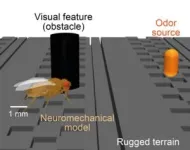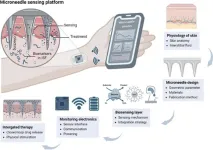(Press-News.org)
What role do dogs play in today’s world? For many, they are more than just pets. New findings from the Department of Ethology at Eötvös Loránd University show that whether seen as friends, family members, children or guardians, these roles affect the way dogs are cared for, suggesting shifting dynamics in human-animal bonds shaped by societal trends and individual owner profiles.
In Western cultures, more and more people see their dogs as their best friends, family members or even their furry children. In fact, past studies have shown that
up to two-thirds of dog owners consider their dog to be more important than any human in their lives.
One reason for these increasingly strong bonds between humans and dogs may be the demographic transition seen over the last few decades, characterised by smaller families and falling birth rates. Indeed, in a time when people feel lonelier and more socially isolated, dogs may have become a perfect substitute for human contact. However, not much scientific research has looked at this societal trend and how it affects the daily lives of dogs.
What is it about dogs that people love so much? Does regarding dogs as friends, children or family members influence the way owners care for them?
To answer these questions, researchers at the Department of Ethology at Eötvös Loránd University (ELTE) have studied questionnaire data collected from about 800 dog owners.
First, results revealed that almost all owners really liked the physical contact with the dog (97.6% of owners), the “unconditional love” the dog provides them (93.7%), and the sight and beauty of the dog (88.4%). Other benefits were less unanimous - for example, 24.3% of owners didn’t benefit from the social interactions generated by their dog, while 36.3% liked it a lot.
One key question was, of course, what role(s) the dog played in the owner’s life. The novelty of the present study was that, instead of just choosing one main role, owners could attribute multiple roles to their dogs, like friend, family member, child, colleague, domesticated animal, and security guard.
“Interestingly, even though we collected data from online groups dedicated to family dogs, the owners weren’t all the same” explained Laura Gillet, PhD student at the Department of Ethology and lead author of the study. “We found three distinct profiles of owners whose dogs played diverse social and practical roles”.
Indeed, for some owners, the dog had dual functions:
both practical as a colleague and a security guard, but also a strong emotional and social function as the most important individual in their lives.
Another group of owners, labelled as “dog parents”, emphasised the human-like roles of the dog, suggesting a very close bond but no practical functions. The last group kept dogs mainly for companionship while showing a greater emotional distance from their pets.
“As we previously assumed, several dog and human factors were associated with these three profiles. For instance, dogs with dual functions were perceived as very obedient and were trained with positive reinforcement and professional training methods like clicker training”, noted Prof. Eniko Kubinyi, head of the Department of Ethology and of the MTA-ELTE “Momentum” Companion Animals Research Group. “Moreover, they often belonged to breeds known for their working abilities, such as Border Collie, Belgian Shepherd Dog and German Shepherd Dog.”
On the other hand, owners keeping dogs for companionship purposes preferred the Mudi, the English Cocker Spaniel and the Labrador Retriever breeds, spent less time with their dogs on a daily basis and were older than other owners. Lastly, “dog parents” were more likely than others to house their dogs indoors only, and their favourite breeds were Border collies, Vizsla, Boxer, and Dachshund.
The researchers also collected information about the behavioural problems of the dogs as indicators of canine welfare,
as these may result from inadequate management practices. The most frequently reported issues were jumping up (33.2% of dogs), chasing animals (28.5%), territoriality (26.7%), overexcitement (20.9%), and fear of new things or situations (19.4%). However, no association was found between these perceived behavioural problems and the roles attributed to the dogs.
In sum, dogs can play many roles in their owners’ lives and provide them with different benefits.
This new research method better captures the complexity of the dog-human bond.
Moreover, the roles that owners attributed to their dogs seem to have direct implications for dogs’ daily lives, although in this convenience sample of dog enthusiasts, endowing dogs with human-like roles had no negative effect on canine welfare.
Finally, the present findings also suggest a generational shift in the perception of the dog-owner relationship, with
younger owners forming stronger emotional bonds with their dogs and more likely to refer to them as children than the previous generation.
More research is needed to better understand the consequences of this phenomenon in terms of animal and human well-being, but also what it says about our modern societies.
END
All animals, large or small, have to move at an incredible precision to interact with the world. Understanding how the brain controls movement is a fundamental question in neuroscience. For larger animals, this is challenging because of the complexity of their brains and nervous systems. But the fruit fly, Drosophila melanogaster, has a smaller and therefore more easily mappable brain, allowing scientists to gain detailed insights into how its nervous system drives behavior.
To understand how the nervous system controls actions, researchers at the group of Pavan Ramdya at EPFL created a simulated reality where a virtual fly can operate ...
Researchers have found evidence that mangrove forests – which protect tropical and subtropical coastlines – are drowning in the Maldives.
Their findings, published today (Tuesday 12 December) in Scientific Reports, indicate that rising sea level and a climate phenomenon known as the Indian Ocean Dipole have led to some Maldivian islands losing over half of their mangrove cover since 2020.
The research team, led by Northumbria University, warn that the findings have implications not only for the Maldives, but also for other island nations and coastal ecosystems around the world.
In 2020, more than a quarter of the Maldivian islands containing mangrove forests saw their trees experiencing ...
There’s no doubt that exercise does a body good. Regular activity not only strengthens muscles but can bolster our bones, blood vessels, and immune system.
Now, MIT engineers have found that exercise can also have benefits at the level of individual neurons. They observed that when muscles contract during exercise, they release a soup of biochemical signals called myokines. In the presence of these muscle-generated signals, neurons grew four times farther compared to neurons that were not exposed to myokines. These cellular-level experiments suggest that exercise can have a significant biochemical effect on nerve growth.
Surprisingly, the researchers also ...
A new paper in Nicotine and Tobacco Research, published by Oxford University Press, finds that people who switch from smoking cigarettes to vaping see improved respiratory health, but people who begin consuming electronic cigarettes while continuing to smoke regular cigarettes do not report improved respiratory symptoms.
Adults increasingly use electronic cigarettes to try to quit smoking because of the perceived reduced risk. But while vaping reduces exposure to toxic chemicals, it has been unclear whether switching from cigarettes to e-cigarettes results in a reduction of the respiratory problems—like wheezing and coughing—common in regular cigarette ...
Boston, Massachusetts, 12 November 2024 – Environmental exposure to air pollutants during critical developmental periods may significantly impact autism risk, according to a groundbreaking Emerging Topic review published 12 November 2024, in Brain Medicine. The study reveals how common air pollutants, including fine particulate matter and nitrogen oxides, can trigger complex biological cascades affecting brain development.
"Different kinds of neurological disorders, including autism spectrum disorder, can be associated ...
Boston, Massachusetts, 12 November 2024 – The complex interplay between nitric oxide and brain disorders takes center stage in the latest Genomic Press Interview, published November 12, 2024, in Brain Medicine. Professor Haitham Amal, head of the Laboratory of Neuromics, Cell Signaling, and Translational Medicine at the Hebrew University of Jerusalem, shares insights into his groundbreaking research and personal motivation.
“Meeting families and children with autism in Boston during my time at MIT inspired me to focus on a single goal: to help develop biological diagnostics ...
Destructive winds during storms and cyclones often cause tree failures, especially through uprooting and stem breakage. However, how trees respond to wind under various forest configurations and weather conditions remains unclear. A recent study on Cryptomeria japonica plots shows that trees dissipate wind energy by switching between two swaying behaviors at specific wind speeds, offering insights that may help in improved forest management to minimize damage caused by storms.
Extreme weather events, such as tropical and extratropical cyclones and tornadoes, can cause widespread damage to forests, leading to environmental and financial ...
Bioprinting is a technology used to create three-dimensional structures, such as human tissues or organs, using bio-inks made of cells and hydrogels. However, conventional inkjet technology has difficulty dispensing bio-inks that are sensitive to temperature due to the heat generated during operation. Furthermore, conventional 3D bioprinting mainly utilizes simple syringe-type printing devices with a single needle, making it time-consuming to produce artificial organs like the brain, lungs, and heart.
The Bionics Research Center team, led by Dr. Byung Chul Lee at the Korea Institute of Science and Technology (KIST, President Sang-Rok Oh), in ...
La version française suit
Opioid use disorder: updated clinical practice guideline
An updated evidence-based guideline aimed at helping clinicians and other health care providers manage patients with opioid use disorder recommends buprenorphine and methadone as first-line treatments. The guideline is published in CMAJ (Canadian Medical Association Journal). https://www.cmaj.ca/lookup/doi/10.1503/cmaj.241173
Opioid use and opioid use disorder are the leading causes of drug-related deaths worldwide, and Canada ...
The rapid advancement in personalized healthcare has driven the development of wearable biomedical devices for real-time biomarker monitoring and diagnosis. Traditional invasive blood-based diagnostics are painful and limited to sporadic health snapshots. To address these limitations, microneedle-based sensing platforms have emerged, utilizing interstitial fluid (ISF) as an alternative biofluid for continuous health monitoring in a minimally invasive and painless manner.
The team led by Wei Gao from California Institute of Technology providea a comprehensive overview of microneedle sensor technology, covering microneedle design, fabrication methods, ...










